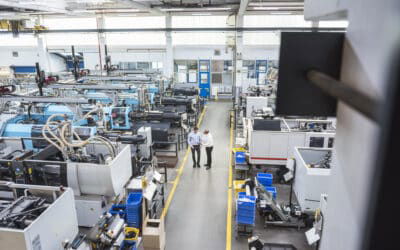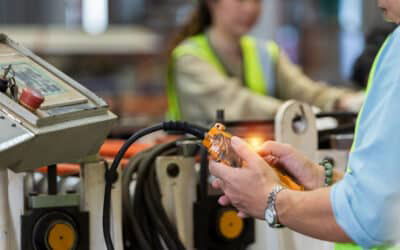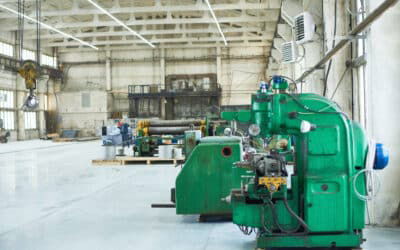L’OEE, ou Efficacité Globale des Équipements, est un indicateur clé utilisé pour mesurer l’efficacité des équipements dans les processus de production. Il permet de quantifier et d’analyser les performances des machines et de détecter les pertes de temps liées aux arrêts, aux baisses de qualité, ou à la sous-utilisation. La mesure de l’OEE est essentielle pour toute usine cherchant à améliorer son efficacité globale et optimiser son système de production.
Définition de l’OEE
L’OEE mesure l’efficacité des machines en prenant en compte trois facteurs : la disponibilité, la performance, et la qualité. Cette mesure permet de déterminer dans quelle mesure une usine utilise ses ressources de façon optimale. L’objectif est de minimiser les pertes et d’atteindre un pourcentage d’OEE le plus élevé possible, généralement 85% ou plus, considéré comme une excellente performance.
Origine et importance de l’OEE
Le taux de rendement synthétique (TRS) ou Overall Equipment Effectiveness (OEE) est un indicateur de performance développé par Seiichi Nakajima dans les années 60 pour mesurer le taux d’utilisation d’une installation industrielle. Le TRS est l’indicateur le plus fréquemment utilisé de nos jours pour mesurer la performance des équipements, même s’il n’existe pas aujourd’hui de consensus international sur cet indicateur.
Néanmoins, la mesure apportée par un tel indicateur est toute relative et est, dans la pratique, plutôt utilisée pour identifier les axes d’amélioration. L’amélioration de l’OEE est mesurée par rapport à une référence pour un équipement donné; la valeur de cet indicateur est donc propre à cet équipement et n’est pas comparable avec des équipements d’autres natures dans d’autres départements ou usines. Maximiser l’OEE ou le TEEP ne signifie donc pas nécessairement atteindre l’optimum global pour l’entité de production.
Le TEEP (Total Effective Equipment Performance) évalue le potentiel total d’utilisation d’un équipement, incluant tous les temps d’arrêt et les périodes non planifiées, contrairement à l’OEE, qui se limite aux heures de production planifiées. Cela permet une vision plus large de l’efficacité potentielle, mais reste un indicateur relatif, propre à chaque machine et contexte.
Composantes de l’OEE
L’OEE repose sur trois composantes majeures :
- Disponibilité : Le temps réel de fonctionnement par rapport au temps total de production planifié, en tenant compte des arrêts.
- Performance : La vitesse réelle de production comparée à la vitesse théorique maximale.
- Qualité : Le ratio entre les produits conformes et ceux nécessitant des corrections ou rejetés. Ces trois aspects sont cruciaux pour avoir une vision globale de l’efficacité d’un système.
Comment calculer l’OEE ?
Le calcul de l’OEE repose sur une formule simple combinant les trois composantes précédemment mentionnées, mais plusieurs méthodes de calcul existent, permettant aux entreprises d’adapter la mesure selon leurs besoins spécifiques. Cela aide à évaluer l’efficacité des machines et à cibler les domaines à améliorer.
Formule de calcul de l’OEE
La formule de calcul de l’OEE est la suivante :
OEE = Disponibilité × Performance × Qualité.
Chacune de ces composantes est exprimée en pourcentage. Par exemple, si une machine est disponible 90% du temps, fonctionne à 95% de sa capacité et produit 98% de produits conformes, l’OEE serait :
OEE = 0.90 × 0.95 × 0.98 = 83.7%
Exemple pratique de calcul de l’OEE
Prenons un autre exemple : une usine planifie 8 heures de production. Sur ces 8 heures, la machine a un arrêt imprévu d’une heure. Cela donne une disponibilité de 87,5%. Si la performance de la machine est à 92% et que 96% des produits sont de haute qualité, l’OEE sera de :
OEE = 87,5% × 92% × 96% = 77,4%. Ce résultat permet de déterminer quelles améliorations peuvent être apportées pour optimiser l’utilisation des machines.
Pourquoi l’OEE est-elle importante ?
L’OEE est cruciale car elle permet de comprendre les performances réelles des équipements, offrant des opportunités pour optimiser les processus de production. En améliorant la disponibilité, la qualité, et la performance, les entreprises peuvent augmenter leur efficacité globale.
Impact sur la productivité
En mesurant et en améliorant l’OEE, les entreprises peuvent augmenter leur productivité sans nécessairement investir dans de nouveaux équipements. Une meilleure utilisation des machines existantes réduit les pertes et améliore le flux de production, augmentant ainsi le nombre de produits finis par cycle.
Réduction des coûts de production
Une OEE bien suivie permet de réduire les arrêts, les dysfonctionnements des machines, et les défauts de qualité, ce qui diminue les coûts liés aux pertes de temps et à la non-conformité des produits. Moins de maintenance non planifiée et moins de déchets entraînent des économies significatives pour l’entreprise.
Amélioration de la qualité des produits
L’OEE permet de détecter rapidement les problèmes de qualité dans le processus de fabrication. En identifiant les causes des défauts, les entreprises peuvent prendre des mesures pour améliorer la qualité des produits, réduire les rebuts et les reprises, et fournir des solutions durables à long terme pour garantir la satisfaction des clients.
Comment améliorer l’OEE ?
L’amélioration de l’OEE passe par l’analyse approfondie des données de production, l’identification des problèmes récurrents, et l’adoption de stratégies efficaces pour maximiser la disponibilité, la performance et la qualité. Cela permet une utilisation optimale des équipements et une meilleure gestion des arrêts imprévus.
Identification des pertes majeures
TEEPTRAK vous permet d’affecter à chaque équipement ou zone suivie un ensemble de catégories de causes de pertes de performance entièrement configurables. Avec les solutions PerfTrak, QualTrak et PaceTrak, ces causes pourront être saisies par l’opérateur sur sa tablette lorsqu’un écart de production (arrêt machine, sous-performance…) lui sera remonté par le module TEEPTRAK.
Ces causes de pertes seront rattachées à des groupes de causes qui composeront les indicateurs de performance. Lors de la construction d’un indicateur, certains groupes de causes pourront être inclus ou exclus du calcul de l’indicateur.
Stratégies pour optimiser l’utilisation des équipements
Parmi les stratégies clés, on trouve l’optimisation des temps de maintenance, l’amélioration des cycles de production, et la réduction des temps d’arrêt. Des outils de suivi en temps réel et des systèmes de calcul d’OEE intégrés aident à identifier les points d’inefficacité et à ajuster les paramètres de production pour maximiser l’efficacité des machines.
Études de cas et exemples concrets
De nombreuses entreprises ont vu leur OEE s’améliorer en adoptant des systèmes de mesure et de suivi continu. Par exemple, une usine de fabrication automobile a augmenté son OEE de 10 pourcent en identifiant les causes d’inefficacité liées aux interruptions fréquentes et en optimisant la disponibilité de ses équipements. Ce type d’optimisation se traduit directement en gains de productivité.
Avantages de l’amélioration de l’OEE
L’amélioration de l’OEE présente de nombreux avantages pour les entreprises cherchant à maximiser la performance de leurs équipements tout en réduisant les pertes dans le processus de production. Cela se traduit souvent par des gains financiers et une meilleure compétitivité sur le marché.
Retour sur investissement
Un OEE amélioré signifie moins de temps d’arrêt et une meilleure utilisation des ressources. Cela conduit à un retour sur investissement plus rapide en réduisant les coûts liés à la maintenance et à la non-conformité des produits. Les entreprises peuvent ainsi investir dans d’autres domaines d’amélioration.
Visualisation de la performance
L’usage d’indicateurs visuels permet une meilleure analyse des performances des machines. Des rapports clairs et en temps réel aident à identifier les problèmes avant qu’ils n’affectent la production. Cela assure une réactivité accrue dans la gestion des cycles de fabrication.
Avantage concurrentiel
En optimisant l’efficacité des équipements, les entreprises peuvent produire plus rapidement des produits de meilleure qualité. Cette amélioration de la performance leur confère un avantage concurrentiel sur le marché, en offrant des solutions plus fiables et compétitives à leurs clients.
Défis liés à l’amélioration de l’OEE
Malgré ses avantages, l’amélioration de l’OEE peut être difficile à mettre en œuvre. Les problèmes courants rencontrés incluent la résistance au changement et les difficultés techniques liées à la collecte et à l’analyse des données.
Problèmes courants rencontrés
Les défis incluent une mauvaise utilisation des systèmes de suivi, des problèmes de formation des équipes ou encore des interruptions fréquentes liées à des défaillances de machines. De plus, il peut être difficile de maintenir un suivi précis de la disponibilité et de la performance des équipements sur le long terme.
Solutions pour surmonter ces défis
Pour surmonter ces défis, il est crucial d’établir des standards clairs pour la mesure de l’OEE et d’intégrer des outils de suivi automatisés. Un rapport régulier sur les performances permet d’identifier les causes des pertes et de mettre en place des programmes de maintenance préventive. L’adoption de formations continues pour les équipes aide également à maintenir une gestion efficace des processus.
Tendances et innovations en matière d’OEE
Les innovations technologiques transforment la manière dont l’OEE est mesurée et suivie. Les entreprises adoptent de nouvelles solutions interactives et automatisées pour améliorer en continu l’efficacité de leurs équipements et la qualité de leurs produits.
Technologies émergentes
L’utilisation de l’IoT et de l’intelligence artificielle dans le suivi des équipements permet une surveillance encore plus précise des données en temps réel. Ces innovations aident à prévenir les arrêts imprévus, optimisant ainsi la disponibilité et la performance des machines.
Outils interactifs et logiciels pour calculer l’OEE
Des logiciels spécifiques et des outils interactifs, comme ceux proposés par TEEPTRAK, facilitent le calcul et la visualisation des indicateurs OEE. Ces outils offrent une meilleure visibilité des processus, permettant aux entreprises de suivre en temps réel leurs performances, d’identifier les pertes, et de prendre des décisions éclairées pour améliorer leur production.





0 Comments